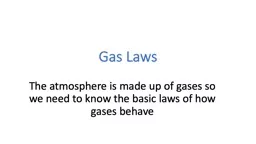

Gas Laws The atmosphere is made up of gases so we need to know the basic laws of how gases behave Gas laws describe the relationships between the 4 key parameters describing the behavior of gases Temperature T ID: 763903
Download Presentation The PPT/PDF document "Gas Laws The atmosphere is made up of ga..." is the property of its rightful owner. Permission is granted to download and print the materials on this web site for personal, non-commercial use only, and to display it on your personal computer provided you do not modify the materials and that you retain all copyright notices contained in the materials. By downloading content from our website, you accept the terms of this agreement.
Gas Laws The atmosphere is made up of gases so we need to know the basic laws of how gases behave
Gas laws describe the relationships between the 4 key parameters describing the behavior of gases Temperature (T) : a measure of the kinetic energy (KE) of atoms and molecules. (°C, °F). Expressed in °K for calculations. Pressure (P) : Force per unit area: F/A. Expressed in Pascal (N/m 2 )-- Newton per meter squared. Often in terms of hPa (100 N/m 2 )
Key Parameters Density ( r ): r = Mass/Volume. R= M/V Expressed in kg/m3 in the metric system. At the earth’s surface r ~ 1 kg/m3 , 1 kg = 1000 grams ~2.2 lbsVolume (V): Expressed in m3
The Key Gas Parameters are Related by GAS LAWS
Boyle’s Law (~1660) Start with a sample of air with a temperature (T), pressure (P), and volume (V). If T is kept constant, then: PV=constant
Boyles Law Basis of air pumps we all use
Law of Charles and Guy Lussac If you increases temperature, while keeping pressure constant, volume will increase. V= constant * T (°K) V = CT So if you increase T, V will increaseBasis of car engines.
One have two gas laws when you can have one?
Can combine both gas laws into one: the Perfect Gas Law (a.k.a., the Ideal Gas Law ) P= rRTWhere r is density (kg m-3), R is a gas constant, P is pressure (Nm-2), and T is temperature (K)One of the key relationships of meteorology
Let’s prove it contains the other laws Start with P= r RT for a particular sample of air (thus mass is constant)Assume T=constant. Then you have: P= r *constant orP = constant* M/V or PV=constant BOYLE’S LAW!
More fun: Law of Charles and Guy Lussac Or assume P=constant. Then you have: Constant=(M/V)*R*T Since Mass and R are constants: Constant= T/VV = constant*T: Law of Charles and Guy Lussac
Gas Law Importance We will these gas laws to explain many weather features The perfect gas law is one of the key relationships used in computer weather forecast models.
Adiabatic Processes Clouds form as air cools when it rises. But why does rising air cool? Air warms as it forced to sink. Why? Why does the spray of aerosol cans feel cold? And why are bike pumps warm after use?
Explained by adiabatic processes! Air parcel: An identifiable collection of air that stays together. Think of the air in balloon. An adiabatic process is a processes that occurs WITHOUT the exchange of energy with the surroundings.In an meteorological context, an adiabatic process is one in which there is no exchange of energy between an air parcel and the surrounding air.
How do temperature and pressure vary for an air parcel under an adiabatic process? Imagine an insulated cylinder with air in it, so NO heat exchange with the outside environment. Push down the piston. Pressure and temperature increases. T 1 , P1T2, P2P2 > P1T2 > T1
Adiabatic processes So if an air parcel is compressed adiabatically , temperature will rise Similarly, if you expand an air parcel, its temperature will fall .Why?When compressing air, you are doing work on the molecules, giving them a “shove” and making them go faster.If you allow the air parcel to expand, it takes energy to push the boundaries of the parcel out (or to push the piston out), resulting in cooling.
To Put It Another Way: The Adiabatic Law In the absence of heat exchange, air warms when compressed and cools when it expands. Explains a great deal of what it occurring in the atmosphere, when air is forced to rise or sink When air is forced to rise, it goes into an environment of lesser pressure (since pressure declines with height). With less pressure on the air parcel, it is able to expand Expansion results in cooling
Adiabatic Law When air sinks, its environment has higher pressure, compressing and warming the air parcel.
Influence on saturation and clouds Adiabatic cooling can result in increased relative humidity and saturation where there is upward motion. The amount of water vapor in the air parcel does not change as it rises, but as the temperature falls, the air parcel has less ability to hold water vapor. Thus, RH increases. With enough vertical motion, the RH climbs to 100% and the air can reach saturation—water condenses out and clouds can form. Mountains are prime example of this process.
Downslope warming and drying On the other hand, when air sinks it warms adiabatically and relative humidity decreases. Clouds thus evaporate, producing a cloud or rain shadow .
Great examples here in Washington
Adiabatic cooling/warming can occur outside of mountains as well
Warm Front
These clouds are associated with adiabatic cooling